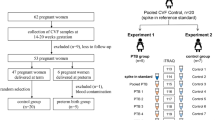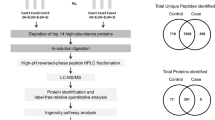Abstract
Liquid chromatography and tandem mass spectrometry without prior fractionation (shotgun proteomics) were used to analyze vaginal fluid from patients admitted for signs and symptoms of preterm labor. The patients had an average age of 26.3 ± 5.9 years, a gestational age of 30.5 ± 2.5 weeks, and a median cervical dilation of 1 cm (range, 0–6 cm). None of the patients exhibited signs of vaginal infection at the time of enrollment. Shotgun proteomics yielded reproducible identifications (R = 0.973) of more than 40 proteins in vaginal fluid samples, such as plasma proteins, epithelial structural proteins, and several immunoregulatory proteins, including some that were previously linked to intra-amniotic infection. This initial characterization of the vaginal fluid proteome using a nonbiased, high-throughput technique yields reproducible results in late pregnancy. The presence of host defense proteins in vaginal fluid suggests that this technique may be useful for future study of inflammation-related preterm birth.
Similar content being viewed by others
References
Martin JA, Hamilton BE, Sutton PD, et al. Births: final data for 2004. Natl Vital Stat Rep. 2006;55:1–101.
Goldenberg RL The management of preterm labor. Obstet Gynecol. 2002;100:1020–1037.
Lockwood CJ Predicting premature delivery-no easy task. N Engl J Med. 2002;346:282–284.
Leitich H., Bodner-Adler B., Brunbauer M., et al. Bacterial vaginosis as a risk factor for preterm delivery: a meta-analysis. Am J Obstet Gynecol. 2003;189:139–147.
Wira CR, Fahey JV The innate immune system: gatekeeper to the female reproductive tract. Immunology. 2004;111:13–15.
Gravett MG, Novy MJ, Rosenfeld RG, et al. Diagnosis of intra-amniotic infection by proteomic profiling and identification of novel biomarkers [published correction appears in JAMA. 2004;292:2340]. JAMA. 2004;292:462–469.
Klein LL, Freitag BC, Gibbs RS, et al. Detection of intra-amniotic infection in a rabbit model by proteomics-based amniotic fluid analysis. Am J Obstet Gynecol. 2005;193:1302–1306.
Buhimschi IA, Christner R., Buhimschi CS Proteomic bio-marker analysis of amniotic fluid for identification of intra-amniotic inflammation. BJOG. 2005;112:173–181.
Ruetschi U., Rosen A., Karlsson G., et al. Proteomic analysis using protein chips to detect biomarkers in cervical and amniotic fluid in women with intra-amniotic inflammation. J Proteome Res. 2005;4:2236–2242.
Buhimschi IA, Buhimschi CS, Weiner CP, et al. Proteomic but not enzyme-linked immunosorbent assay technology detects amniotic fluid monomeric calgranulins from their complexed calprotectin form. Clin Diag Lab Immunol. 2005;12:837–844.
Yates JR III, McCormack AL, Schieltz D., et al. Direct analysis of protein mixtures by tandem mass spectrometry. J Protein Chem. 1997;16:495–497.
McCormack AL, Schieltz DM, Goode B., et al. Direct analysis and identification of proteins in mixtures by LC/MS/MS and database searching at the low-femtomole level. Anal Chem. 1997;69:767–776.
Raffi RO, Moghissi KS, Sacco AG Proteins of human vaginal fluid. Fertil Steril. 1977;28:1345–1348.
Valore EV, Park CH, Igreti SL, et al. Antimicrobial components of vaginal fluid. Am J Obstet Gynecol. 2002;187:561–568.
Rohan LC, Edwards RP, Kelly LA, et al. Optimization of the weck-Cel collection method for quantitation of cytokines in mucosal secretions. Clin Diag Lab Immunol. 2000;7:45–48.
Jun JK, Yoon BH, Romero R., et al. Interleukin 6 determinations in cervical fluid have diagnostic and prognostic value in preterm premature rupture of membranes. Am J Obstet Gynecol. 2000;183:868–873.
Rizzo G., Capponi A., Vlachopoulou A., et al. Interleukin-6 concentrations in cervical secretions in the prediction of intrauterine infection in preterm premature rupture of the membranes. Gynecol Obstet Invest. 1998;46:91–95.
Rizzo G., Capponi A., Rinaldo D., et al. Interleukin-6 concentrations in cervical secretions identify microbial invasion of the amniotic cavity in patients with preterm labor and intact membranes. Am J Obstet Gynecol. 1996;175:812–817.
Matsuda Y., Kouno S., Nakano H. Effects of antibiotic treatment on the concentrations of interleukin-6 and interleukin-8 in cervicovaginal fluid. Fetal Diagn Ther. 2002; 17:228–232.
Kurkinen-Raty M., Ruokonen A., Vuopala S., et al. Combination of cervical interleukin-6 and -8, phosphorylated insulin-like growth factor-binding protein-1 and trans-vaginal cervical ultrasonography in assessment of the risk of preterm birth. BJOG. 2001;108:875–881.
Tanaka Y., Narahara H., Takai N., et al. Interleukin-1β and interleukin-8 in cervicovaginal fluid during pregnancy. Am J Obstet Gynecol. 1998;179:644–649.
Hitti J., Hillier SL, Agnew KJ, et al. Vaginal indicators of amniotic fluid infection in preterm labor. Obstet Gynecol. 2001;97:211–219.
Balu RB, Savitz DA, Ananth CV, et al. Bacterial vaginosis, vaginal fluid neutrophil defensins, and preterm birth. Obstet Gynecol. 2003;10:862–868.
Peaceman AM, Andrews WW, Thorp JM, et al. Fetal fibronectin as a predictor of preterm birth in patients with symptoms: a multicenter trial. Am J Obstet Gynecol. 1997;177:13–18.
Yoon BH, Romero R., Moon JB, et al. The frequency and clinical significance of intra-amniotic inflammation in patients with a positive cervical fetal fibronectin. Am J Obstet Gynecol. 2001;185:1137–1142.
Resing KA, Meyer-Arendt K., Mendoza AM, et al. Improving reproducibility and sensitivity in identifying human proteins by shotgun proteomics. Anal Chem. 2004;76:3556–3568.
Wolters DA, Washburn MP, Yates JR III. An automated multidimensional protein identification technology for shotgun proteomics. Anal Chem. 2001;73:5683–5690.
Carrell RW alpha 1-Antitrypsin: molecular pathology, leukocytes, and tissue damage. J Clin Invest. 1986;78: 1427–1431.
Knight KR, Burdon JG, Cook L., et al. The proteinaseantiproteinase theory of emphysema: a speculative analysis of recent advances into the pathogenesis of emphysema. Respirology. 1997;2:91–95.
Pfundt R., van Ruissen F., van Vlijmen-Willems IM, et al. Constitutive and inducible expression of SKALP/elafin provides anti-elastase defense in human epithelia. J Clin Invest. 1996;98:1389–1399.
Draper DL, Landers DV, Krohn MA, et al. Levels of vaginal secretory leukocyte protease inhibitor are decreased in women with lower reproductive tract infections. Am J Obstet Gynecol. 2000;183:1243–1248.
Molmenti EP, Ziambaras T., Perlmutter DH Evidence for an acute phase response in human intestinal epithelial cells. JBiol Chem. 1993;268:14116–14124.
Abe T., Kobayashi N., Yoshimura K., et al. Expression of the secretory leukoprotease inhibitor gene in epithelial cells. J Clin Invest. 1991;87:2207–2215.
Moriyama A., Shimoya K., Ogata I., et al. Secretory leukocyte protease inhibitor (SLPI) concentrations in cervical mucus of women with normal menstrual cycle. Mol Hum Reprod. 1999;5:656–661.
Bhat AR, Isaac V., Pattabiraman TN Protease inhibitors in serum and amniotic fluid during pregnancy. Br J Obstet Gynaecol. 1979;86:222–227.
Burnett D., Bradwell AR The origin of plasma proteins in human amniotic fluid: the significance of α1-antichymotrypsin complexes. Biol Neonate. 1980;37:302–307.
Conneely OM Antiinflammatory activities of lactoferrin. J Am Coll Nutr. 2001;20:389S–395S.
Fluckinger M., Haas H., Merschak P., et al. Human tear lipocalin exhibits antimicrobial activity by scavenging microbial siderophores. Antimicrob Agents Chemother. 2004;48:3367–3372.
Goetz DH, Holmes MA, Borregaard N., et al. The neutrophil lipocalin NGAL is a bacteriostatic agent that interferes with siderophore-mediated iron acquisition. Mol Cell. 2002;10: 1033–1043.
Costantini S., Di Capua E., Zerega B., et al. Pilot study on lipocalin expression into extracellular fluids of women in fertile age. Minerva Ginecol. 2002;54:387–392.
Pentecost BT, Teng CT Lactotransferrin is the major estrogen inducible protein of mouse uterine secretions. J Biol Chem. 1987;262:10134–10139.
Chen J., Chen Z., Chintagari NR, et al. Alveolar type I cells protect rat lung epithelium from oxidative injury. J Physiol. 2006;572:625–638.
Kjeldsen L., Johnsen AH, Sengelov H., et al. Isolation and primary structure of NGAL, a novel protein associated with human neutrophil gelatinase. J Biol Chem. 1993;268:10425–10432.
Mallbris L., O’Brien KP, Hulthen A., et al. Neutrophil gelatinase-associated lipocalin is a marker for dysregulated keratinocyte differentiation in human skin. Exp Dermatol. 2002;11: 584–591.
Nielsen BS, Borregaard N., Bundgaard JR, et al. Induction of NGAL synthesis in epithelial cells of human colorectal neoplasia and inflammatory bowel diseases. Gut. 1996;38:414–420.
Kjeldsen L., Cowland JB, Borregaard N. Human neutrophil gelatinase-associated lipocalin and homologous proteins in rat and mouse. Biochim Biophys Acta. 2000;1482:272–283.
Leclair EE Four BPI (bactericidal/permeability-increasing protein)-like genes expressed in the mouse nasal, oral, airway and digestive epithelia. Biochem Soc Trans. 2003;31:801–805.
Espinoza J., Chaiworapongsa T., Romero R., et al. Antimicrobial peptides in amniotic fluid: defensins, calprotectin and bacterial/ permeability-increasing protein in patients with microbial invasion of the amniotic cavity, intra-amniotic inflammation, preterm labor and premature rupture of membranes. J Matern Fetal Neonatal Med. 2003;13:2–21.
Gerke V., Moss SE Annexins: from structure to function. Physiol Rev. 2002;82:331–371.
Passey RJ, Xu K., Hume DA, et al. S100A8: emerging functions and regulation. J Leukoc Biol. 1999;66:549–556.
Striz I., Trebichavsky I. Calprotectin-a pleiotropic molecule in acute and chronic inflammation. Physiol Res. 2004;53:245–253.
Romero R., Mazor M. Infection and preterm labor. Clin Obstet Gynecol. 1988;31:553–584.
Author information
Authors and Affiliations
Corresponding author
Additional information
Supported by grants from the March of Dimes (JLM, RSG); University of Colorado at Denver & Health Sciences Center, Department of Obstetrics and Gynecology, Academic Enrichment Fund (LLK and JLM); and National Institutes of Health (NIH) P30 DK048520 (Mass Spectrometry Core). The authors thank Eric J. Kushner for technical assistance with 2D gels and Dr M. C. Neville for helpful comments.The CNRU Mass Spectrometry Core is supported by NIH/NIDDK P30 DK048520.
Rights and permissions
About this article
Cite this article
Klein, L.L., Jonscher, K.R., Heerwagen, M.J. et al. Shotgun Proteomic Analysis of Vaginal Fluid From Women in Late Pregnancy. Reprod. Sci. 15, 263–273 (2008). https://doi.org/10.1177/1933719107311189
Published:
Issue Date:
DOI: https://doi.org/10.1177/1933719107311189




